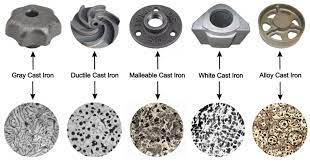Cast iron is a versatile and widely used material in various industries, known for its exceptional strength, durability, and heat resistance. It comes in several distinct forms, each with its own unique properties and applications. In this comprehensive guide, we will delve into the different types of cast iron, exploring their characteristics, manufacturing processes, and primary uses.
1. Gray Cast Iron: Gray cast iron is one of the most common and recognizable forms of cast iron. It is named for its grayish appearance due to the graphite flakes in its microstructure. This type of cast iron offers excellent castability, good machinability, and damping properties. It is widely used in applications such as engine blocks, pipes, and cookware due to its heat dissipation capabilities.
2. White Cast Iron: White cast iron is characterized by its white, hard, and brittle structure. It contains cementite, which gives it its hardness. While it lacks ductility, it excels in wear resistance, making it suitable for applications like grinding balls and hardfacing materials in heavy industries.
3. Ductile Cast Iron (Nodular Cast Iron): Ductile cast iron, also known as nodular cast iron or spheroidal graphite iron, is prized for its high tensile strength and ductility. It features graphite nodules instead of flakes, which enhance its toughness. This type of cast iron is commonly used in automotive components, pipes, and construction materials.
4. Malleable Cast Iron: Malleable cast iron is produced by heat-treating white cast iron or compacted graphite iron. It combines the castability of gray iron with the ductility of ductile iron. Malleable iron is used in applications where both strength and ease of machining are required, such as pipe fittings and automotive parts.
5. Compacted Graphite Iron (CGI): Compacted graphite iron, or CGI, possesses a microstructure that falls between gray and ductile iron. It exhibits high strength, excellent thermal conductivity, and improved fatigue resistance, making it suitable for engine components in the automotive industry.
6. Austempered Ductile Iron (ADI): Austempered ductile iron is produced by heat-treating ductile cast iron. This process results in a material with exceptional strength, wear resistance, and fatigue properties. ADI finds applications in gears, shafts, and heavy-duty machinery components.
7. Chilled Cast Iron: Chilled cast iron is produced by cooling the molten metal rapidly, creating a hard and wear-resistant outer layer. It is often used for applications requiring hardness and abrasion resistance, such as rolls in the steel industry and cutting tools.
8. Ni-Resist Cast Iron: Ni-Resist cast iron is known for its corrosion resistance, making it suitable for applications exposed to harsh environments, such as pumps, valves, and marine components. It contains high levels of nickel and chromium, enhancing its resistance to corrosion and oxidation.
9. High-Chromium Cast Iron: High-chromium cast iron contains significant amounts of chromium, resulting in excellent wear resistance and high-temperature strength. This type of cast iron is commonly used in applications like pump components, grinding media, and parts exposed to abrasive wear.
10. Alloyed Cast Iron: Alloyed cast iron encompasses a wide range of cast iron alloys tailored to specific applications. These alloys often include elements like nickel, copper, and molybdenum to enhance properties such as corrosion resistance, thermal conductivity, or magnetic characteristics. Alloyed cast iron can be found in industries ranging from aerospace to electronics.
Conclusion: Understanding the various types of cast iron is crucial when selecting the right material for your specific application. Each type of cast iron offers unique properties and advantages, and choosing the appropriate one can significantly impact the performance and longevity of your products. Whether you require the high strength of ductile cast iron, the wear resistance of white cast iron, or the corrosion resistance of Ni-Resist cast iron, there is a cast iron variant suitable for your needs. By considering the characteristics and applications of these cast iron types, you can make informed decisions that contribute to the success of your projects and products.


No comments yet